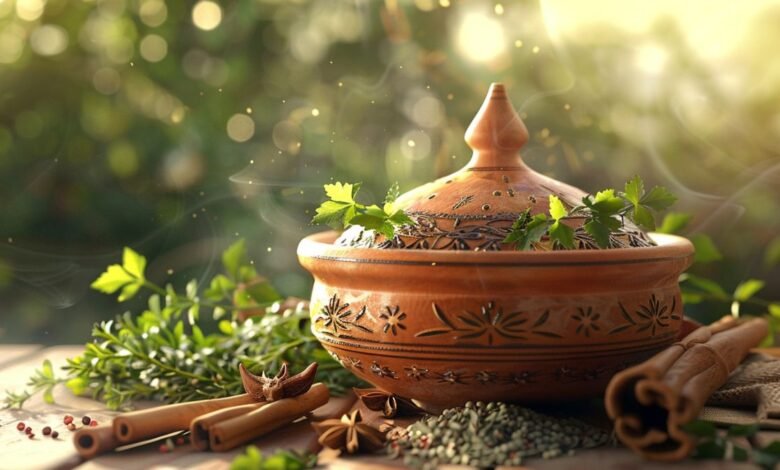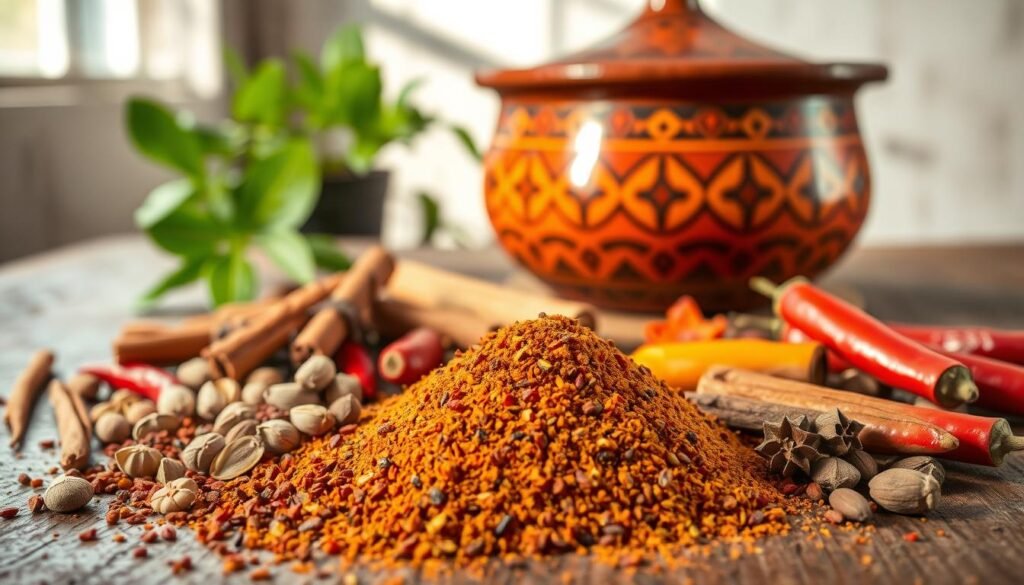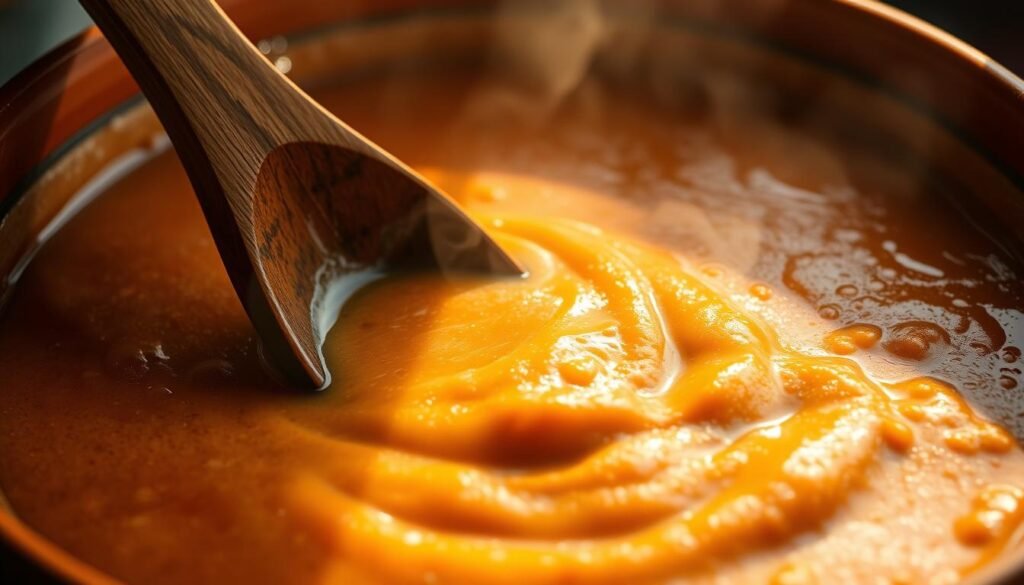
You remember the first time a slow, fragrant pot filled your kitchen and everyone paused mid-conversation. That hush is the prize. It comes when meat falls apart, spices float on warm steam, and the table fills with small, eager hands reaching for bread.
This guide will show the basic principles behind the tagine and how its conical lid keeps moisture cycling for fork-tender results. You’ll learn practical steps: curing new clay, layering aromatics, managing liquids, and finishing with bright lemon zest and toasted almonds for texture.
Along the way, you’ll see plain translations for home kitchens. Dutch ovens, slow cookers, and Instant Pots can stand in when the tagine pot is absent, with tips on avoiding thin sauces and scorched dishes. The goal is simple: confident, repeatable dishes that honor Moroccan recipes while fitting your pantry and schedule.
Key Takeaways
- Tagine design traps steam for tender, deeply flavored food.
- Cure new clay and heat gently to protect the pot.
- Brown aromatics, add liquids sparingly, and simmer low and slow.
- Use couscous, lemon zest, and toasted almonds for finishing texture.
- Translate methods to Dutch ovens and Instant Pots with attention to liquid loss.
Tagine Fundamentals: What It Is, How It Works, and Why It’s Unique
The design matters more than decoration. The cone-shaped lid and shallow base work as a single system that controls steam and heat so your food stays moist and tender.
The cone traps rising vapor, condenses it, and returns it as droplets. This self-basting loop means you add minimal water; the dish relies on ingredients’ own juices and a little added water for the cooking medium.
The clay or ceramic tagine pot heats slowly and holds heat evenly. That gentle transfer prevents scorching and lets spices, onions, and aromatics bloom over long, low temperature cooking.
Design and material advantages
- Base: wide and shallow for even browning before simmering.
- Lid: conical for moisture recirculation and controlled venting.
- Material: clay buffers temperature shifts and deepens flavor over time.
| Feature | Benefit | Practical effect |
|---|---|---|
| Conical lid | Traps and returns steam | Self-bastes stews, keeps meat succulent |
| Shallow base | Wide heat exposure | Consistent browning of onions and proteins |
| Clay construction | Even, gentle heat | Prevents scorching; intensifies spice and ingredient flavors |
Setting Up Your Tagine: Curing, Heat Management, and Safe Use
Start by treating the vessel gently; proper setup keeps clay healthy and flavors bright. Prepare the base and lid well before you place any food inside.
Soak and season. Fully soak tagine parts in water for 24 hours. Dry them, then rub the interior with olive oil by hand. The tagine pot should be heated for approximately two hours at 225°F in a cold oven. Let the clay cool inside the oven after turning it off.
- On gas, always use a metal heat diffuser to protect the base and spread warmth evenly.
- Choose the oven for steady ambient heat or the stovetop when you need quick adjustments in minutes.
- Prevent thermal shock: warm and cool the pot slowly and never pour cold water into hot clay.
Handle the hot lid with oven mitts and lift it away from your face. For longevity, wash by hand, avoid soapy soaking, and let the tagine pot dry thoroughly before storage.
how to cook using a tagine: A Practical Overview
Begin by arranging fragrant layers that will slowly transform into a rich, concentrated sauce.
Layer aromatics first: place onions, garlic, and ginger in the base, then sprinkle your spice mix so the heat can bloom the flavors. Brown meat in batches on the stovetop to build fond; this gives the sauce depth rather than plain stewing.
Sauté tomato paste with spices briefly to toast them, then return meat and add vegetables. Add just enough water or stock to create steam; the goal is moisture, not drowning the ingredients.
Low and slow makes the difference
Keep the lid firmly on the tagine pot and hold a low temperature for hours. That slow cooking breaks collagen and concentrates the sauce as liquid reduces.
Add delicate vegetables and dried fruit later so they keep their shape. Finish the dish with lemon zest and toasted almonds for bright contrast and crunch.
| Step | Action | Effect |
|---|---|---|
| Layer aromatics | Onions, garlic, ginger, spice mix | Builds base flavor and aroma |
| Brown meat | In batches until seared | Creates fond for deeper sauce |
| Gentle simmer | Lid on, low temperature, minimal water | Collagen breaks down; sauce concentrates |
| Finish | Add fruit late; lemon zest; toasted nuts | Texture and bright flavor lift |
Spice Strategy: Ras el Hanout and Other Flavor Builders
Start your flavor plan with a single warm blend that guides every addition.
Ras el hanout is the anchor here. This fragrant mix often pairs coriander, cumin, cardamom, turmeric, fennel, cloves and a touch of cayenne. Use two teaspoons as a base and adjust for your taste.

Balancing warm spices
Bloom whole or ground spices in olive oil with onions, garlic, and ginger. That releases fat-soluble aromas and gives depth.
Smart swaps and heat control
Choose cinnamon sticks over ground cinnamon for a subtler roundness. Dial cayenne up or down to control perceived heat. If you lack one spice, boost cumin and coriander slightly to keep balance.
Foundational flavors
Finish the pot by stirring tomato paste into the aromatics briefly. It adds body without tasting tomatoey. For rich proteins like lamb, use a bolder hand; lighter proteins want less forceful seasoning.
- Example finishing: chopped coriander and a drizzle of olive oil.
- Keep a jar of ras hanout on hand for quick tagine recipe pulls.
| Element | Role | Tip |
|---|---|---|
| Ras el hanout | Primary flavor | Warm, not fiery |
| Cinnamon stick | Rounded aroma | Remove before serving |
| Tomato paste | Body | Toast briefly with spices |
Choosing Ingredients: Proteins, Vegetables, and Flavorful Add-Ins
Select cuts and add-ins that will melt, sing, or hold their shape through hours of slow braising. Your choices set the dish’s texture and final flavor.
Proteins: Favor well-marbled, connective tissue-rich cuts such as lamb shoulder and beef chuck; they break down into silky meat and enrich the sauce.
For poultry-based dishes, such as a traditional Moroccan Chicken Tagine with preserved lemon and olives, chicken thighs are ideal. Their higher fat content keeps the meat tender and flavorful during the long, gentle simmer typical of tagine cooking. For a quicker turn, meatballs are an excellent example — season them with ras el hanout and brown lightly before nesting in the pot.
Vegetables and add-ins: Build a base with onions and carrots for natural sweetness. Add potatoes later so they cook through without falling apart. Dried apricots give sweet pops, while green olive and preserved lemon bring briny brightness.
- Use a thin film of oil when sautéing aromatics so spices bloom evenly.
- Handle fragile items by hand and add fruit and olives near the end so they keep shape.
- Balance richness with a little lemon zest at the finish to lift heavy meat-forward food.
| Component | Role | Tip |
|---|---|---|
| Lamb shoulder | Tenderness, sauce body | Long simmering yields melting texture |
| Chicken thighs | Moist poultry | Resists drying; add earlier |
| Dried apricots & olives | Sweet and briny contrast | Add near the end for texture |
Step-by-Step: From Prep to Plate
Start by prepping each ingredient so every piece finishes at the same tender point. Trim and cut your protein into larger, uniform pieces. Toss them with a fresh spice mix and salt in a shallow bowl so seasoning spreads evenly.
Prep and season
Trim and portion: larger cuts resist falling apart while the sauce reduces. Coat meat lightly with oil and spices before it hits the pot.
Brown or sweat
Heat the pot and brown meat in batches for about 3 minutes each. This builds fond and avoids stewing. For chicken or vegetable-centered dishes, sweat onions and garlic until soft.
Add liquids and manage heat
Toast tomato paste, ginger, cinnamon, and spices in oil for about 1½ minutes to remove raw edges. Pour in stock or water conservatively and scrape up browned bits. Fit the lid and hold a gentle simmer on the stovetop or in the oven.
Timing by minutes and hours
Think in minutes and hours, not seconds. Add potatoes and dried fruit partway through so they become tender but keep their shape. Check after key intervals and adjust heat rather than adding more liquid.
Finish and rest
Turn off the heat and let the pot rest a few minutes. Finish with lemon zest, toasted almonds, and chopped coriander. Serve hot with couscous, rice, or bread so every drop of sauce is enjoyed at the ideal serving temperature.
| Action | Timing | Effect |
|---|---|---|
| Brown meat in batches | ~3 minutes per batch | Builds fond; deeper sauce |
| Toast aromatics & spices | ~1½ minutes | Removes raw spice flavor; adds depth |
| Simmer covered | Minutes to hours | Collagen breaks down; sauce concentrates |
| Add fruit/potatoes | Midway through simmer | Keeps shape; balances sweetness |
No Tagine? Cook Tagine-Style in Common Cookware
Common kitchen vessels can mimic the tagine’s gentle steam loop when you match technique to tool. Use the same core moves: bloom spices in fat, layer aromatics and protein, add just enough liquid, then hold a low temperature for tender results.
Dutch oven: this pot is the closest stand-in. Oven-braise at moderate heat for even warmth and steady reduction. The tight lid helps concentrate sauce and yields tender meat over hours.
Slow cooker: it traps moisture. Start with less liquid and finish uncovered or on a sauté setting to tighten a thin sauce. That step prevents dilution and recovers deep spice notes.
Instant Pot: pressure for 10–20 minutes, then use sauté for a few minutes to reduce. Layer potatoes on top after pressure release so they keep shape and resist turning mushy.
- Use a heat diffuser on gas to protect delicate cookware.
- Scale recipes so meat fits snugly and liquid covers sparingly.
- Finish with lemon zest and toasted nuts for texture and lift.
| Method | Key action | Result |
|---|---|---|
| Dutch oven | Oven-braise at low temp | Even heat, concentrated sauce |
| Slow cooker | Less liquid; finish uncovered | Rich flavor, proper thickness |
| Instant Pot | Short pressure then sauté | Fast tenderizing; reduced sauce |
Heat and Sauce Control: Troubleshooting Common Issues
Small adjustments in heat and liquid often fix the most stubborn tagine problems. Use a quick check halfway through a bake or simmer to judge reduction and texture.

Too thick or too thin sauce? If the sauce has over-reduced, add a splash of stock or water and lower the oven temperature slightly. If it’s too thin, remove the lid and let steam escape, or extend slow cooking until it concentrates.
Preventing sticking, scorching, and cracking
On gas, place a heat diffuser under the base to avoid hot spots. Moderate the flame and warm clay slowly when using a tagine pot.
Never pour cold water into a hot pot. Gentle temperature shifts protect the clay from cracking and keep stews tasting clean.
Keeping vegetables and meat intact
Cut vegetables to sizes that match their cooking time and add them later if they are fragile. Lift the lid sparingly; each lift drains heat and lengthens cooking.
Stir only near the end, use a little oil to reduce sticking, and finish flat sauces with acid—lemon zest or preserved lemon—and salt after reduction for bright, balanced results.
| Issue | Quick fix | Why it works |
|---|---|---|
| Over-reduced sauce | Add stock; lower heat | Restores moisture without losing flavor |
| Scorching | Use heat diffuser; add thin cushion of liquid | Prevents hot spots and burning |
| Mushy vegetables | Add later; larger cuts | Keeps shape and texture |
Serving and Sides: The Best Way to Plate Tagine Dishes
A well-plated tagine highlights contrasts: soft meat, bright herbs, and crunchy nuts. Aim for a simple base that soaks up every drop of sauce.
Choose a side that drinks up sauce: plain couscous is ideal because it lets richly spiced sauce shine. Rice or Moroccan bread (khobz) work the same way. Warm the side before plating so heat carries through each bite.
Finish with fresh texture and brightness. Scatter toasted slivered almonds and chopped coriander over the top. Add lemon zest for an immediate lift that cuts rich flavors in minutes.
- Plate in a warm bowl and spoon sauce over protein so vegetables and meat glaze evenly.
- Offer briny accents like sliced green olive or chopped preserved lemon for contrast with sweet dried fruit.
- Keep sides neutral when your pot is heavily spiced; simple bases make each tagine dish sing.
| Element | Role | Serving tip |
|---|---|---|
| Plain couscous | Absorbs sauce | Fluff with fork; serve hot in a bowl |
| Toasted almonds | Crunch | Add at end so they stay crisp |
| Preserved lemon/olive | Briny contrast | Serve on the side for guests |
Conclusion
,A successful finish depends on steady heat and attentive timing more than luck.
You now have a clear path: steady heat control, patient slow cooking over hours, and precise finishing for concentrated flavor. Anchor recipes with ras hanout and tweak your spice mix and ground additions to match ingredients and taste.
Whether you use a traditional tagine or adapt a Dutch oven, slow cooker, or pressure device, the core method stays the same. Choose reliable proteins like lamb shoulder, beef chuck, or chicken thighs — or try meatballs for a quicker weeknight tagine recipe.
Respect the vessel: soak tagine once, warm slowly, and use a heat diffuser on gas. Finish with lemon zest and toasted almonds, serve hot, and enjoy sharing moroccan recipes that people will remember.